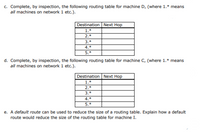
Computer Networking: A Top-Down Approach (7th Edition)
7th Edition
ISBN: 9780133594140
Author: James Kurose, Keith Ross
Publisher: PEARSON
expand_more
expand_more
format_list_bulleted
Question

Transcribed Image Text:c. Complete, by inspection, the following routing table for machine D, (where 1.* means
all machines on network 1 etc.).
Destination Next Hop
1.*
2.*
3.*
4.*
5.*
d. Complete, by inspection, the following routing table for machine C, (where 1.* means
all machines on network 1 etc.).
Destination Next Hop
1.*
2.*
3.*
4.*
5.*
e. A default route can be used to reduce the size of a routing table. Explain how a default
route would reduce the size of the routing table for machine I.

Transcribed Image Text:1. This question is about Networks
The following diagram shows a set of interconnected networks. The six networks
(networks 1-6) are shown as labelled ellipses and the machines (A-K) connected to
the networks represented as letters. Some machines (such as C, and E) are connected
to multiple networks and are set to forward packets between the two networks.
For the purposes of this questions, machines will be addressed using the format 1.A
where the number refers to the network the machine is connected and the letter
identifies the machine. Machines connected to multiple networks can be addressed
using multiple addresses – for example, machine c can be referred to as 1.c or 2.c
depending on which network it is talking to.
E-
Network 3
-F
Network 4
Network 1
Network 2
H.
A
Network 5
K
The network is configured to use next-hop routing. In the following questions, you are
required to specify the address of the next-hop where a machine should send a packet,
If it is not on the same (local) network as the machine in question. If the machines are
on the same network then you can just say the packet would be sent locally.
a. Where should machine A send packets destined for machine C?
b. Where should machine G send packets destined for machine J?
Expert Solution
This question has been solved!
Explore an expertly crafted, step-by-step solution for a thorough understanding of key concepts.
Step by stepSolved in 2 steps

Knowledge Booster
Similar questions
- I am completely clueless about routing and how it works. It is crucial to be aware of the differences between these two popular routing methods.arrow_forwardList three different types of “distance” other than the geographic distance for a routing algorithm to minimize in finding the shortest distance.arrow_forwardWhat are some of the advantages of open shortest path first over other dynamic routing protocols? What are some of the disadvantages of open shortest path first over other dynamic routing protocols?arrow_forward
arrow_back_ios
arrow_forward_ios
Recommended textbooks for you
 Computer Networking: A Top-Down Approach (7th Edi...Computer EngineeringISBN:9780133594140Author:James Kurose, Keith RossPublisher:PEARSON
Computer Networking: A Top-Down Approach (7th Edi...Computer EngineeringISBN:9780133594140Author:James Kurose, Keith RossPublisher:PEARSON Computer Organization and Design MIPS Edition, Fi...Computer EngineeringISBN:9780124077263Author:David A. Patterson, John L. HennessyPublisher:Elsevier Science
Computer Organization and Design MIPS Edition, Fi...Computer EngineeringISBN:9780124077263Author:David A. Patterson, John L. HennessyPublisher:Elsevier Science Network+ Guide to Networks (MindTap Course List)Computer EngineeringISBN:9781337569330Author:Jill West, Tamara Dean, Jean AndrewsPublisher:Cengage Learning
Network+ Guide to Networks (MindTap Course List)Computer EngineeringISBN:9781337569330Author:Jill West, Tamara Dean, Jean AndrewsPublisher:Cengage Learning Concepts of Database ManagementComputer EngineeringISBN:9781337093422Author:Joy L. Starks, Philip J. Pratt, Mary Z. LastPublisher:Cengage Learning
Concepts of Database ManagementComputer EngineeringISBN:9781337093422Author:Joy L. Starks, Philip J. Pratt, Mary Z. LastPublisher:Cengage Learning Prelude to ProgrammingComputer EngineeringISBN:9780133750423Author:VENIT, StewartPublisher:Pearson Education
Prelude to ProgrammingComputer EngineeringISBN:9780133750423Author:VENIT, StewartPublisher:Pearson Education Sc Business Data Communications and Networking, T...Computer EngineeringISBN:9781119368830Author:FITZGERALDPublisher:WILEY
Sc Business Data Communications and Networking, T...Computer EngineeringISBN:9781119368830Author:FITZGERALDPublisher:WILEY

Computer Networking: A Top-Down Approach (7th Edi...
Computer Engineering
ISBN:9780133594140
Author:James Kurose, Keith Ross
Publisher:PEARSON

Computer Organization and Design MIPS Edition, Fi...
Computer Engineering
ISBN:9780124077263
Author:David A. Patterson, John L. Hennessy
Publisher:Elsevier Science

Network+ Guide to Networks (MindTap Course List)
Computer Engineering
ISBN:9781337569330
Author:Jill West, Tamara Dean, Jean Andrews
Publisher:Cengage Learning

Concepts of Database Management
Computer Engineering
ISBN:9781337093422
Author:Joy L. Starks, Philip J. Pratt, Mary Z. Last
Publisher:Cengage Learning

Prelude to Programming
Computer Engineering
ISBN:9780133750423
Author:VENIT, Stewart
Publisher:Pearson Education

Sc Business Data Communications and Networking, T...
Computer Engineering
ISBN:9781119368830
Author:FITZGERALD
Publisher:WILEY